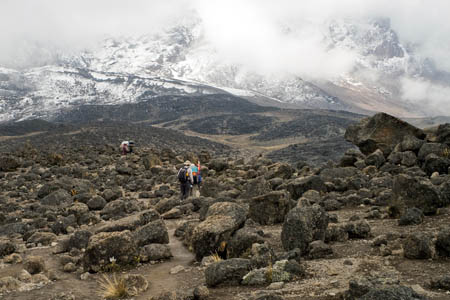
Grough has an interesting article up on the dangers of climbing Kilimanjaro, which are detailed thanks to a new study that calls it one of the most dangerous mountains in the world.
The study was conducted by British doctor Jeremy Windsor and American Dr George Rodway. Windsor, who is an advisor to the Union Internationale des Associations d’Alpinisme, is quoted as saying “Despite reliable weather and straightforward access, illness and injury are commonplace” on Kili. The report cites the fact that guide fees and services put an emphasis on getting up and down quickly, not allowing for many climbers to acclimatize properly.
While I obviously respect the mountain, and think that it is far more challenging than the average trekker realizes before they go, I have to disagree with the good doctors that it’s one of the most dangerous mountains in the world. Sure, any time you’re dealing with high altitudes there can be issues. Throw in the fact that you’re in a remote place, with challenging terrain, and you’ve added a layer of complexity to the problem. But thousands of people go up and down Kilimanjaro each year, mostly without incident, and there are relatively few deaths on the mountain when you look at the amount of traffic there. It’s non-technical nature also insulates it to some degree, although unprepared and inexperienced climbers probably are the biggest cause for concern.
To illustrate my point, the article goes on to talk about the dangers of making the climb, but references many issues that are not even a concern on the mountain. For instance, Windsor says that there are an alarming number of electrocutions with visitors to Tanzania due to substandard wiring in hotels. While obviously a concern, how is that related to Kili exactly? They go on to discuss HIV/AIDS, as well as other diseases, and even the risk of a fatal car accident, which is the number one killer of visitors to the country.
They do eventually talk more in detail about the actual issues on the mountain itself, touching on altitude sickness, and all the issues that can bring along with it. They also talk about exposure and the colder temperatures up near the summit, but that isn’t nearly as much of a concern as it is on a lot of other mountains.
All in all, an interesting article, even if I don’t necessarily agree with everything they are saying. Certainly it’s a good read for those planning a trip to Africa to make the climb. My word of advice is respect the altitude, give yourself plenty of time, and enjoy the scenery along the way. Oh! And careful when plugging things into the electrical outlets apparently. 😉
- Gear Review: The Xero Scrambler Mid is an Ultralight Hiking Shoe for Spring - March 1, 2023
- Gear Review: Yeti Roadie 48 Wheeled Cooler - August 18, 2022
- Kristin Harila Continues Pursuit of 8000-Meter Speed Record - August 16, 2022
Great post! Do you know where they got their figures for the failure rates? Seems quite high to me. I’ve linked to this from http://kiliadventures.blogspot.com/ as well.
Thanks,
–Daniel
Hi Daniel,
Cool blog! I love Kili!
Not sure where they got there numbers from, and as you probably know, there are widely varying numbers on the success rate. I generally tell people to expect it to be harder than you think. 😉
The article is interesting, but they list a lot of “dangers” that are outside of the mountain itself, which I thought was odd.
I have just returned from a successful summit ascent on Kibo (Kilimanjaro) – having taken a seven day Machame route. The very knowledgeable guide seemed to think that there was about a 50:50 success rate to the summit overall, with the highest failure rate being due to altitude sickness on the faster ascending Marangu (Coca cola) route. The guide recommended acclimatisation..acclimatisation..aacclimatisation and sop the more days that a person can afford to spend at high altitudes before the final summit climb the better the chance of success.
Also, the temperatures on final summit night are NO JOKE. I wore 5 pairs of tropusers and seven tops (including a puffer jacket) and was still virtually hyperthermic…so take LOTS of warm clothing layers.
I ascended the mountain with my 20 year old daughter (I am a female aged 45)and I think that we both made it to the top as we walked very very slowly from day one and gave our bodies the maximum chance of acclimatizing.
Best of luck to all those doing it…the experience is fabulous!!
Thanks for the insights and sharing your experiences on Kili. That is always appreciated around here. 🙂